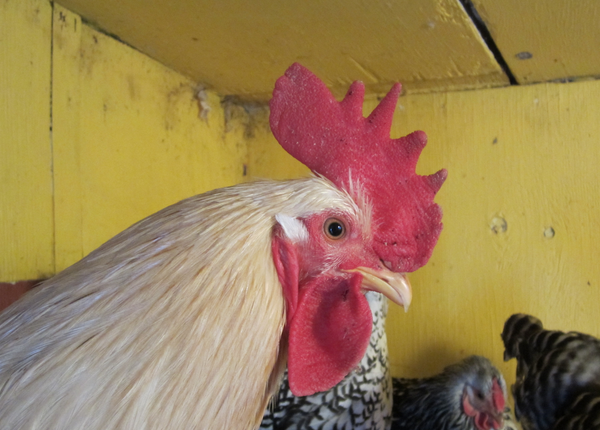
This morning, as I was weeding the garden for chicken treats, I realized the main reason I keep laying hens is likely more for the rooster crowing than even for the hens themselves; some years ago I made peace with the fact that, not being much of an egg consumer, it’s definitely not for the eggs.
Today, for the first time in many years, my yard was silent. There was no 4 am crow to incorporate into my dreams, as so often happens in the summer, and no crow to greet me when I came out to feed the dogs and chickens. Roo Paul was gone – taken away yesterday by the Rooster Remover, because yes, I am too “chicken” to dispatch problem birds myself.
I am a total rooster booster. But even as such, I have limits. Roo Paul crossed them a few weeks ago when suddenly and without warning he decided to establish a pecking order with me. Since I was wearing jeans, his first two body slams merely resulted in him getting thoroughly whacked with the broom. As Mr. Broom seemed to have reestablished the pecking order in my favor, I gave the matter no further thought (and had no further trouble) until the weather hit 90 and I started wearing shorts to do yard chores.

To the right is a visual of what happens when in fact the pecking order is still at issue within a rooster’s mind. I had a bruise the size of a chicken body for a couple of weeks, not to mention two fairly deep punctures on my calf; these were from his claws (talons?) not from his spurs which, thankfully, had yet to grow out. But it was the issue of those soon to be very long and very sharp spurs that was foremost in my mind as I mulled: ”Should he stay or should he go?”
Aggressive (or overly protective) roosters are a dilemma that can arise anytime one decides to have a mixed flock. For flocks that are free-ranged a lot, or where there are no small children or other visitors, a flock owner may want a protective rooster; it is hard to fault a bird for doing what it is genetically programmed to do: protect his hens. In my case, while I was willing to deal with a certain amount of back talk from my rooster, my chicken yard has a lot of visitors and alternate caretakers, including children. Having a feisty rooster capable of puncturing legs was not an option.
Since I am admittedly a soft touch with all of my birds, I gave Roo Paul a month to clean up his act. We had some negative reinforcement interactions consisting of a spray bottle (then a more powerful squirt gun), as well as the dreaded broom. I found that if I distracted appeased the rooster with treats he would leave me alone. But if I turned my back, he would frill his neck feathers and prepare to attack – most particularly if I wore shorts.
And it was that deviousness – his clear distinction between jeans and bare legs – that yesterday led me to summon the Rooster Remover (a friend and fellow flock owner who is happy to take and consume unwanted roosters).
So, Roo Paul is gone and I can move about freely again amongst my hens. It’s never a decision I make easily but it is one I realize I will encounter from time to time if I want to have a rooster with my flock.
Some breeds are just more aggressive than others. Roo Paul was a red-sex link: crossed with a Rhode Island Red. The last rooster that I was forced to condemn (because it would stalk and nail me in the hen house when collecting eggs) was also smart, devious and hard-hitting, and… a Rhode Island Red. Maybe it is just been my bad luck with Rhode Island Reds, but for sure, I won’t ever take a rooster if it has even a whiff of Rhode Island Red in its breeding.
In about a month, I will be getting a new rooster – this one a cross of a Wynadotte and an Americana – both breeds that are generally calm, placid and not highly assertive. In the meantime, while all of the females in the yard are breathing a sigh of relief (the hens also experiencing a lot of pecking and harassment from Roo Paul), it’s eerily quiet. Even though there is always the risk of a rooster passing the limit of “decent” behavior, for me their crowing is what makes a backyard flock a backyard flock…
Alaska Backyard Chickens is a resource for Alaskans and others living in northern climates who are interested in keeping chickens. Maintained by the Community Development Agent at the Cooperative Extension Service/University of Alaska Fairbanks, this site offers information for the hobbyist flock owner, such as what works (and doesn’t) in arctic coop design, and how to keep flocks healthy and productive through long winters. While small egg/meat producers are welcome, the site is designed for those who keep chickens to fulfill their household needs for eggs and meat. And of course – for people who just think chickens are cool birds!




